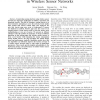Free Online Productivity Tools
i2Speak
i2Symbol
i2OCR
iTex2Img
iWeb2Print
iWeb2Shot
i2Type
iPdf2Split
iPdf2Merge
i2Bopomofo
i2Arabic
i2Style
i2Image
i2PDF
iLatex2Rtf
Sci2ools
GLOBECOM
2010
IEEE
2010
IEEE
Finding and Mending Barrier Gaps in Wireless Sensor Networks
Constructing sensing barriers using wireless sensor networks has important applications in military operations and homeland security. The goal of forming a sensing barrier is to detect intruders attempting to cross the network. Early studies often assume that sensors remain static once deployed. We note that barrier gaps may occur at deployment if sensors are deployed at random. Barrier gaps may also occur in an existing barrier if some sensors used to form the barrier start malfunctioning or run out of power. We present an efficient solution to solve this problem. In particular, we devise an efficient algorithm to find sensing gaps and relocate mobile sensors to form a new barrier while balancing the energy consumption among mobile sensors. We also investigate the related design issues and performance tradeoffs. Simulation results show that our algorithms can effectively improve the barrier coverage of a wireless sensor network under a wide range of deployment parameters. These result...
| Added | 11 Feb 2011 |
| Updated | 11 Feb 2011 |
| Type | Journal |
| Year | 2010 |
| Where | GLOBECOM |
| Authors | Anwar Saipulla, Benyuan Liu, Jie Wang |
Comments (0)

